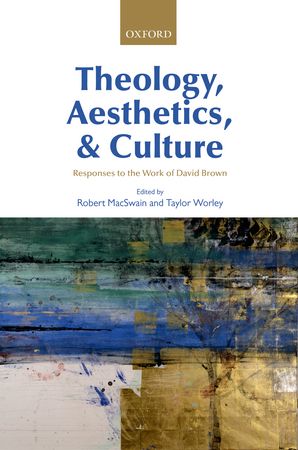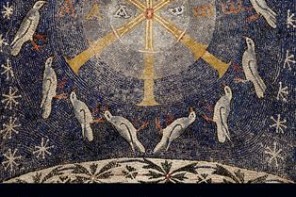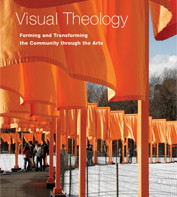 Editor’s note: This is the second of a three-part review (see the first part here) of Robert MacSwain and Taylor Worley, eds. Theology, Aesthetics, & Culture: Responses to the Work of David Brown. Oxford: Oxford University Press, 2012, 313 pp., £68.00/$125.00 cloth.
Editor’s note: This is the second of a three-part review (see the first part here) of Robert MacSwain and Taylor Worley, eds. Theology, Aesthetics, & Culture: Responses to the Work of David Brown. Oxford: Oxford University Press, 2012, 313 pp., £68.00/$125.00 cloth.
In continuing our analysis of the work of David Brown as presented in the volume Theology, Aesthetics, & Culture I’d like to look at two key voices whose contribution to the conversation of theology and the arts has become irreplaceable: Jeremy Begbie and Gavin Hopps. In this volume both Begbie and Hopps offer unique responses to Brown’s own claims regarding music that I’d like to look at more closely.
Begbie’s response (ch. 11) is a mixture of appreciation for, as well as “misgivings” concerning, Brown’s project, particularly as it relates to his discussion of classical music in God and Grace of Body. Begbie praises Brown’s book as being “informed,” “accessible,” and “interesting” before identifying four “guiding passions” which characterize Brown’s overall work in theology, aesthetics and culture (145). The first two are related, having to do with Brown’s recognition of “the generous presence of God in areas of human endeavor where God is not overtly recognized or acknowledged as present,” and “a repeated stress on the importance of . . . a generous attentiveness on the part of the theologian” seeking to discern that presence (146). Thirdly, Begbie identifies Brown’s respect for “the integrity and particularity of cultural endeavour” which allows the arts “to do their own work in their own ways,” to be “given space to be themselves,” and so “heard as potential mediators of the divine” before suffering critical evaluation. Fourthly, with respect to theological criteria, Begbie notes Brown’s insistence that “Scripture should be acknowledged as belonging to a continuum of culturally embedded tradition” as opposed to privileging the Bible as “occupying a normative criteriological role ‘over’ or ‘above’ extra-scriptural tradition” (147).
It is this fourth approach that leads to Begbie’s “misgivings” concerning Brown’s project. In contrast to Brown, Begbie wishes to emphasize “the Church’s repeated return to” the “texts” of Scripture “as normative for Christian wisdom and understanding.” “Need there be anything intrinsically contradictory,” Begbie inquires, “about holding to the epistemic and existential primacy of Scripture for the life of the Church while at the same time endorsing the Church’s need for post-biblical tradition?” (149-50). It is the absence of any clear theological criteria for assessing an extra-textual Christian tradition that creates problems for Begbie.
While Begbie is certainly appreciative of Brown’s passion “to recognize the width of divine presence in the world at large,” he is hesitant to “invest quite so much” as Brown “in the language and ontology of ‘presence,’” preferring instead “to characterize these ‘rumours of transcendence’ in terms of God’s grace-ful, reconciling action, linked to a far more overt and developed doctrine of the Holy Spirit” (153). Similar to Trevor Hart’s criticism of Brown’s project (ch. 17) which we will consider in the third part of our review, Begbie seeks a more distinctly Christian and theologically-conservative approach to discovering and describing the extent of God’s involvement with human creativity than the one Brown has chosen.
Gavin Hopps’s instructive essay (ch. 12) is a fitting tribute to the “salutary generosity” marking “Brown’s sacramental vision” (167). Limiting himself to Brown’s discussion of pop music, Hopps shows not only a generosity of appreciation equal to Brown’s own treatment of the subject, but, again like Brown, a mastery over an impressive breadth of material. This latter ranges from pop artists such as Kylie, Nick Cave, Sigur Rós, Muse, and Morrissey to thinkers as diverse as Adorno, Derrida, Marion, Maritain, Newman, Percy Shelley, and Susan Sontag.
Calling attention to the “unexamined and pervasive prejudice against pop music as an art-form,” Hopps delights in Brown’s capacity to approach pop music with “maximum seriousness.” Indeed, both Hopps and Brown are united in their mutual discovery that “pop music is linked to the survival of religion” (159).
As Hopps points out, Brown seeks to do for pop music what Percy Shelley once did in defense of poetry—isolate its capacity to redeem “from decay the visitations of divinity in man” [1]. Unlike the atheist Shelley, however, Hopps finds the “warrant” and rationale behind “Brown’s saving of and hospitality towards that which is not fully, explicitly or univocally committed to the religious” to be both “theological (it is predicated on the undelimited generosity of God) and biblical (it is what Christ did)” (167).
With the generosity of Brown’s vision generously extolled, Hopps wonders if Jean-Luc Marion’s work on the “saturated phenomenon” might not signal a similar effort to redeem those cultural artifacts often dismissed as “kitsch” or “camp.” Hopps brings the two together by arguing that “in the camp gaze as well as Brown’s sacramental vision, the work of art is able to transcend its own content and “‘give more than it has,’” an action which “reveals the possibility of an ‘iconic’ opening in even the most thoroughly aestheticized work” (167).
Hopps’s comparison is purposive, for in concluding with a juxtaposition of “camp” and Brown’s work he is in no way attempting cheapen “Brown’s ambitious project of theological re-enchantment.” On the contrary, through his comparison Hopps underscores the provocative “question” Brown’s “project challenges us to address: Is it not possible even in the most fallen, trivial and apparently God-forsaken forms to discover an efficacious experience of God?” (168). As it is a pertinent question—one well worth posing and wrestling with—we may be thankful for the many ways it is addressed both in Brown’s five books in focus and this present volume of responses.
It is to the critical response of Trevor Hart to the work of David Brown and particularly his text God and Mystery in Words: Experience through Metaphor and Drama that we will turn to next week.
Review by Travis Buchanan





